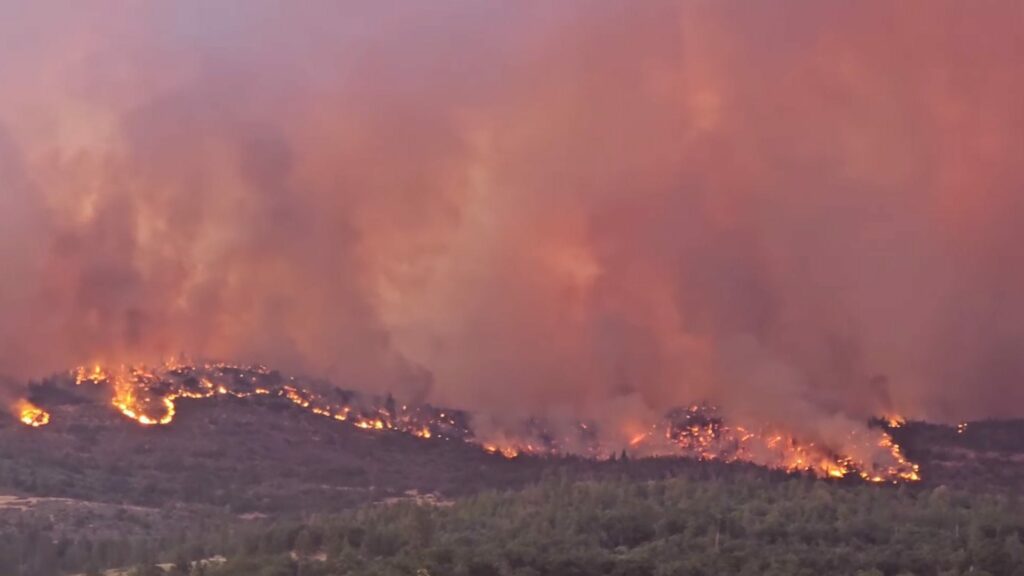Meteorologists warned that temperatures will climb “above the historical average” across a large swath of the eastern U.S. through Tuesday.
Wildfires on West Coast burn thousands of acres
Multiple states in the West are dealing with excessive heat and rapidly spreading wildfires.
Tens of millions of Americans remained under heat alerts on Monday as a record-breaking heat wave expanded into portions of the central and eastern U.S., threatening urban areas with “particularly intense” temperatures, forecasters warned.
The unrelenting heat wave, which has set dozens of records and has been tied to at least 30 fatalities in the West, has scorched much of the western U.S. and parts of the South, Southeast, mid-Atlantic and southern New England over the last week. More than 140 million Americans were under some form of heat alert on Monday, according to Heat.gov.
Along the East Coast, heat alerts were in effect from as far north as Maine and as far south as Florida.
“A broad heat wave from the Plains to the East Coast will continue over the next couple of days, becoming particularly intense for many of the urban centers in the Southeast, Ohio Valley and along the East Coast,” the National Weather Service said.
AccuWeather meteorologists warned that temperatures will climb “above the historical average” across a large swath of the eastern U.S. through Tuesday.
Most urban areas in the Southeast, Ohio Valley, and along the East Coast will be at a major to extreme risk from the heat, the weather service said. These conditions will be “dangerous and potentially deadly for those without adequate access to effective cooling and hydration,” the weather service added.
Numerous record-tying and record-breaking temperatures were possible along the East Coast, and portions of the Ohio Valley and Southeast, according to the weather service.
Forecasters said the combination of hot temperatures and high humidity brings heat indices into the 105 to 110-degree range. Overnight temperatures were expected to be warmer in the mid to upper 70s, which will provide “little relief from the heat.”
The heat also baked residents in southeast Texas as hundreds of thousands remained without power after Hurricane Beryl hit the region earlier in the week. As of Monday afternoon, over 280,000 had no power, according to Poweroutage.us.
The lack of electricity and hot temperatures forced some residents to seek refuge in their cars as others packed into the homes of relatives or slept in cooling centers. At least one death is believed to be linked to heat exposure while at least two people in Harris County died from carbon monoxide poisoning, a major risk when operating home generators, USA TODAY previously reported.
Heat wave death counts? Don’t trust them. The true toll is higher.
Thunderstorms forecast in northern Plains to upper Mississippi Valley
While heat blanketed a large portion of the U.S., forecasters said multiple clusters of strong to severe thunderstorms threatened parts of the north-central U.S. Monday.
Damaging wind gusts were the primary threat, according to the weather service. Some large hail and a few tornadoes were also possible.
The Storm Prediction Center said there was an “enhanced” risk of severe weather over parts of Illinois, Iowa and Indiana, states where severe wind gusts were possible Monday afternoon and evening. The risk area includes the entire Chicago metro area.
Blistering heat evaporates millions of gallons of water in Northern California
The weekslong heat wave is also responsible for the disappearance of hundreds of millions of gallons of water in major reservoirs in Northern California.
In the first nine days of July, more than 3,000 cubic feet per second of water — or about 2.2 billion gallons — evaporated off Lake Shasta, a man-made lake created by the construction of Shasta Dam across the Sacramento River. According to the Northern California Water Association, the Shasta Reservoir is California’s largest man-made lake.
That is a substantial amount of water, said Don Bader, area manager for the U.S. Bureau of Reclamation, which manages Shasta Dam. The bureau also reported other reservoirs that have lost millions of gallons of water during the first nine days of July, including 828.5 million gallons of water from Trinity Lake near Weaverville and 47.1 million gallons off Keswick Lake near Redding.
Contributing: Christopher Cann, USA TODAY; Damon Arthur and James Ward, USA TODAY Network
Source link : https://www.usatoday.com/story/news/nation/2024/07/14/heat-wave-united-states-summer-weather/74402852007/
Author :
Publish date : 2024-07-16 08:02:17
Copyright for syndicated content belongs to the linked Source.
